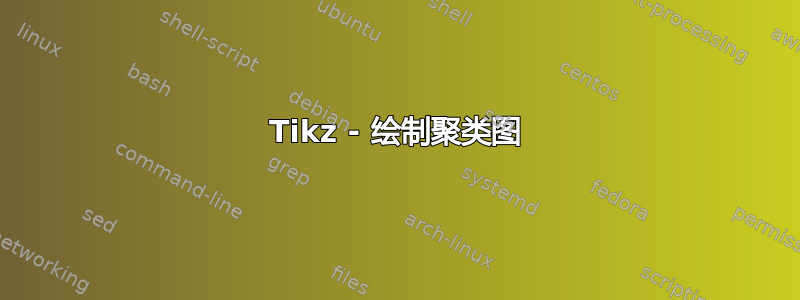
答案1
将此视为Asymptote MWE一个起点:
// cluster.asy
//
// run asy cluster.asy
//
// to get cluster.pdf
settings.tex="pdflatex";
import graph;
import math;
size(12cm,9cm);
import fontsize;defaultpen(fontsize(9pt));
texpreamble("\usepackage{lmodern}"+"\usepackage{amsmath}"
+"\usepackage{amsfonts}"+"\usepackage{amssymb}"
);
real lineW=0.8bp;
real dotW=3bp;
pen shapePen0=darkblue+lineW;
pen shapePen1=deepred+lineW;
pen shapePen2=deepgreen+lineW;
pen dotPen0=shapePen0+dotW;
pen dotPen1=shapePen1+dotW;
pen dotPen2=shapePen2+dotW;
struct Cluster{
guide shape;
int ndots;
pair[] dots;
pen shapePen,dotPen;
void genDots(){
pair ll=min(shape);
pair ur=max(shape);
guide bb=box(ll,ur);
real w=abs(ll.x-ur.x);
real h=abs(ll.y-ur.y);
pair p;
int n=0;
while(n<ndots){
p=shift(ll)*scale(w,h)*(unitrand(),unitrand());
if(inside(shape,p)){
dots.push(p);
++n;
}
}
draw(shape,shapePen);
dot(dots,dotPen);
}
void operator init(guide shape,explicit int ndots
,pen shapePen=currentpen, pen dotPen=currentpen
){
this.shape=shape;
this.ndots=ndots;
this.dots=new pair[];
this.shapePen=shapePen;
this.dotPen =dotPen;
genDots();
}
}
pair[] Distance0={
(29, 22),(25, 24),(23, 26),(20, 31),(18, 37),(12, 37),(8, 37),
(6, 35),(6, 33),(6, 29),(4, 21),(5, 17),(10, 15),(12, 13),
(16, 12),(20, 14),(21, 18),(25, 18),(28, 19),(30, 20),
};
pair[] Distance1={
(46, 31),(42, 40),(34, 42),(28, 42),(25, 39),(22, 36),
(22, 31),(26, 27),(29, 26),(32, 24),(39, 25),(44, 28),
};
pair[] Distance2={
(59, 23),(55, 23),(53, 25),(49, 23),(42, 22),(41, 19),(42, 10),
(44, 9),(45, 4),(47, 2),(52, 3),(55, 5),(56, 8),(58, 11),(60, 16),
};
pair[] Density0={
(43,28),(40,33),(38,37),(33,40),(26,41),(21,39),(16,40),
(16,37),(16,34),(19,29),(26,26),(34,25),(39,26),
};
pair[] Density1={
(61,22),(60,24),(51,26),(41,25),(29,22),(16,30),(14,36),(11,37),
( 7,37),( 1,24),( 4,12),(11,10),(26, 4),(43, 3),(50, 6),(57,13),
};
pair[] Gest0={
(44, 37),(37, 36),(33, 34),(31, 30),(32, 25),(35, 22),(38, 22),
(41, 20),(45, 17),(46, 14),(45, 11),(43, 8),(38, 6),(33, 5),(29, 5),
(29, 4),(30, 4),(34, 4),(39, 5),(43, 7),(47, 10),(48, 14),(46, 18),(43, 21),
(39, 23),(36, 24),(33, 26),(33, 29),(35, 33),(38, 34),(44, 36),(44, 36),
};
guide[] g={ // all shapes
graph(Distance0,operator..)..cycle,
graph(Distance1,operator..)..cycle,
graph(Distance2,operator..)..cycle,
shift(2.5cm,0)*graph(Density0,operator..)..cycle,
shift(2.5cm,0)*graph(Density1,operator..)..cycle,
shift(2*2.5cm,0)*graph(Gest0,operator..)..cycle,
shift(2*2.5cm,0)*box((5, 1),(58, 2)),
};
srand(1456477);
Cluster[] Distance={
Cluster(g[0],20,shapePen0,dotPen0),
Cluster(g[1],20,shapePen1,dotPen1),
Cluster(g[2],20,shapePen2,dotPen2),
};
Cluster[] Density={
Cluster(g[3],20,shapePen0,dotPen0),
Cluster(g[4],3*20,shapePen1,dotPen1),
};
Cluster[] Gest={
Cluster(g[5],20,shapePen0,dotPen0),
Cluster(g[6],20,shapePen1,dotPen1),
};
real dotw=3bp;
pair ul=point(currentpicture,plain.NW);
pair ur=point(currentpicture,plain.NE);
label("Distance", ((5*ul+ur).x/6, ul.y+3mm));
label("Density" , ( (ul+ur).x/2, ul.y+3mm));
label("Shape" , ((ul+5*ur).x/6, ul.y+3mm));
drawline((2.3cm,0),(2.3cm,0)+plain.N,gray(0.6)+1bp);
drawline((5cm,0),(5cm,0)+plain.N ,gray(0.6)+1bp);




